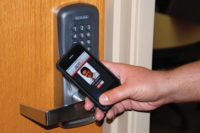So Sell Advertising and Make Money

Where I live, just a couple of blocks from Wrigley Field, the big conflict is naming rights for the Cubs Park. The current owner, the Tribune Company, has placed the ballpark on the block. To extend its revenue, the Tribune folks want to sell Wrigley in two packages – the team and its park and the naming rights to the park.
No doubt, it makes business sense. The Mets inked a $400 million deal with Citibank for a long-term relationship.
But what about security systems?
The City of Chicago, for example, just rolled out a 4,500 camera network that includes the public schools in an integrated security video system. Chicago Mayor Richard Daley also wants to connect into the private security video systems, too. Last month, we reported on how Walgreens is incorporating public view cameras in its latest security video upgrade. Both could include advertising.

Advertisements on
retail security systems not only create more revenue but also reduce the
hard-edge of security portals.
Making Money from Security
There is no doubt that retail security is looking at revenue from security.To date, retail loss prevention has been a cost center for retailers, save for the shrinkage prevented by such security, of course.
Now, however, a New York-based media company has found a way to transform a component of retail security – store entrance pedestals -- into revenue-generating opportunities. StoreBoard Media converts the pedestals into indoor billboards, without compromising the stanchions’ security function.
StoreBoard Media presently has the exclusive rights to place their indoor, patent pending EyeCurve billboards on the security pedestals at the entrances to more than 10,000 chain drug stores nationwide, including CVS, Duane Reade, Longs, Jewel-Osco and others, and is about to launch an expansion initiative into shopping malls, department stores and other retail chain stores.
The company works closely with Checkpoint Systems and Sensormatic, who together produce 99 percent of the retail security systems in the United States.
While StoreBoards presents a revenue generating opportunity for retailers – more than off-setting the cost of the pedestals themselves -- advertisers have embraced the concept because they know their message will reach 100 percent of shoppers.
“In this world of fragmented multiple media messages, we are a simple yet powerful mass medium that is only aisles away, not miles away, from consumers’ point-of-decision, which is a major attraction for some advertisers,” says Douglas Leeds, chief executive of StoreBoards Media. “It is important to understand that we are positioned as a media buy, and thus do not compete with other in-store media options for merchandising/trade dollars.”

Avoiding Visual Clutter
StoreBoard Media only accepts one advertiser per four-week cycle to avoid visual clutter for the retailer. More importantly, because the advertising cycles are only four weeks long, consumers are greeted each month with a fresh new look.The company sells, produces, installs and verifies the installations on behalf of the stores and advertisers. The only responsibility for the retailer is to approve the advertiser’s graphics prior to printing.
StoreBoards’ advertisers to date include P&G, Unilever, Hershey, Energizer, Vonage, Kraft, Adams, L’Oreal, Maybelline, Pfizer, Redi-Clinics, Wyeth, CBS Television and CW11.
StoreBoards represents a simple, yet exciting new medium that is a win-win for both retailers and advertisers. It increases product and category sales, adds retail excitement and generates media revenue that is simply not normally available to retailers.
Looking for a reprint of this article?
From high-res PDFs to custom plaques, order your copy today!






